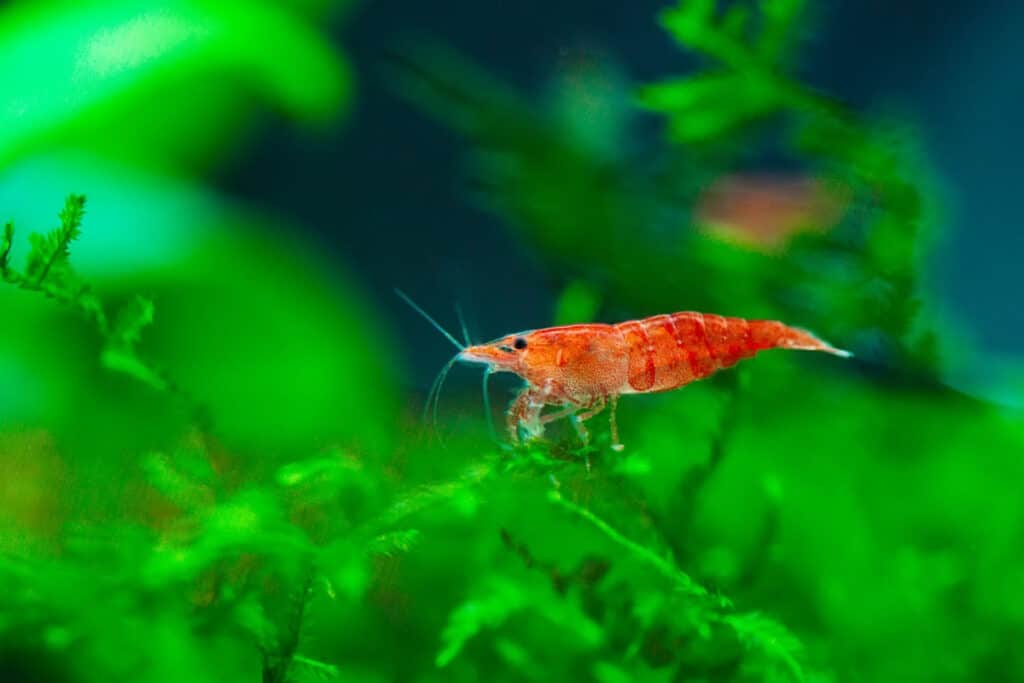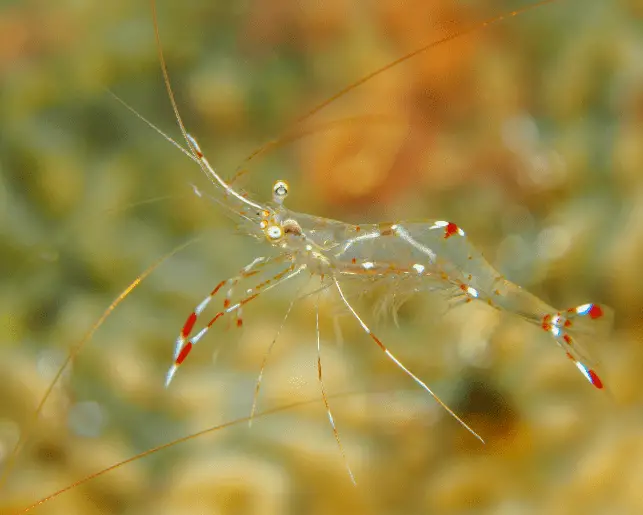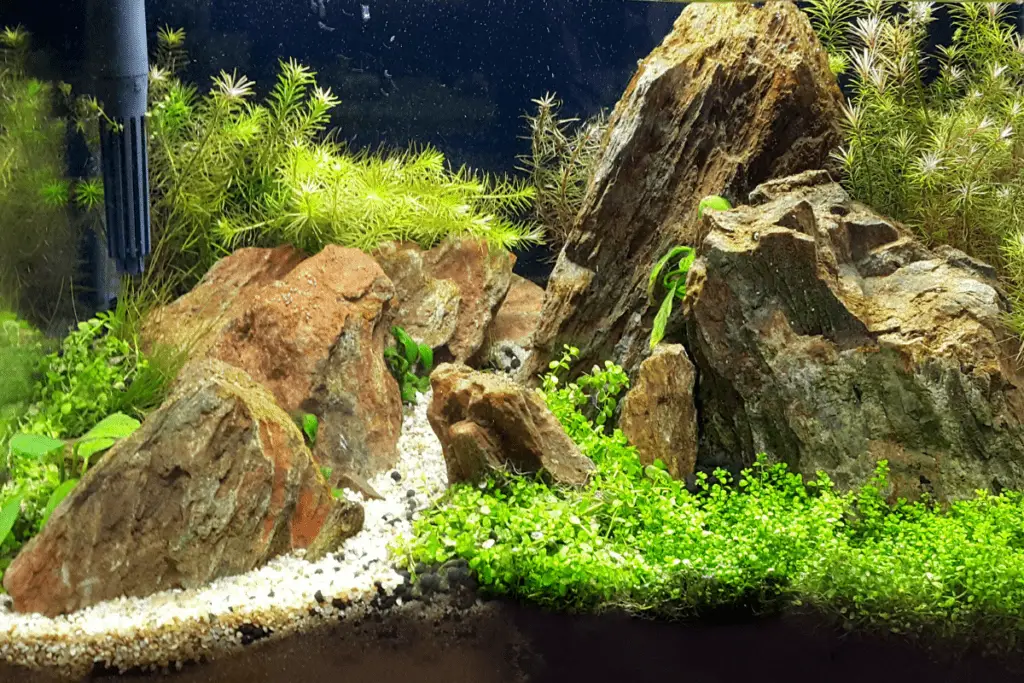Guppies are popular aquarium fish because they have delightful colors and are low-maintenance. Suppose you’ve been thinking about introducing shrimp to your aquarium. But you wonder if the shrimp are safe around guppies—will guppies eat your shrimp?
Guppies will possibly eat shrimp if there isn’t enough aquatic vegetation to hide in. Your shrimp won’t be safe around the guppies either if you haven’t fed them and they’re hungry. Guppies are more likely to eat molting or baby shrimps due to their size, making them easy prey.
Read on for a comprehensive explanation of why guppies may eat shrimp. You’ll also learn if fish and shrimp can live together in a community tank. I’ll also provide some valuable tips on protecting your shrimp from guppies and the different kinds of aquarium shrimp you can consider.
Types of Shrimp
When aquarium enthusiasts choose shrimp, they usually consider ones from the following genera:
- Neocardina
- Caridina
- Atyopsis
- Palaemonetes
I’ll discuss the shrimp within these 4 groups below:
Neocardina
Neocardina shrimp are also called dwarf shrimp due to their tiny size. They’re so tiny that you may need to take precautionary steps to cover your aquarium’s filter to prevent them from getting sucked inside.
This shrimp variety is excellent for beginners because it can thrive under most aquarium conditions. Neorcardina shrimp can withstand a wide temperature and pH range.
Popular examples of Neocardina shrimp include:
- Red cherry
- Dwarf cherry
- Rili
- Sunkist orange
- Yellow
- Fire red cherry
- Snowball
- Crystal

Caridina
If you’ve successfully kept aquarium shrimp in the past, it might be time to consider a more challenging variety, such as the Caridina shrimp. Although these shrimp are more expensive and need soft water in the aquarium, they have incredibly beautiful colors and markings, making them worth the investment.
Here are some common examples of Caridina shrimp:
- King Kong
- Amano
- Deep blue bolt
- Galaxy
- Tangerine tiger

One of the main benefits of keeping these shrimp varieties is that they do an excellent job of helping you clean your tank. They love eating algae build-up and other microbes in the water.
Keeping your aquarium’s water on the soft side for these shrimp is easier than you think. By introducing any of these items, you can create the ideal conditions for Caridina shrimp:
- Water softener aquarium pillows
- Peat moss
- Driftwood
Atyopsis
Atyopsis (or bamboo shrimp) are exciting shrimp to have in your aquarium due to their unique feeding method. Instead of eating tiny algae particles, bacteria, and plankton through their mouths, they have filtering appendages to take in nutrition.
Bamboo shrimp are peaceful and delicate, making them vulnerable to large, aggressive fish, like bettas or angelfish, which will easily eat them.
Palaemonetes
Like Neocardina, Palaemonetes shrimp thrive under most aquarium conditions and are easy to keep. They’re also called ghost or glass shrimp and are larger than the Neocardina, making them less likely to be eaten if you have large or aggressive fish.

Ghost shrimp prefer warmer water conditions (between 65 and 80°F/18 and 26.7°C), so it’s advisable to keep them with fish that also prefer warm water. Examples include:
- Discus
- Tetra
- German rams
As scavengers and omnivores, they enjoy eating anything that comes their way, as long as it fits in their mouths.
Can Shrimp and Fish Live Together in a Community Tank?
I’ve explained the different shrimp varieties, so now you’re probably wondering if you need a separate aquarium for them or if shrimp and fish can live together in a community tank.
Shrimp and fish can live together in a community tank, but it depends on the type of fish and shrimp you have. Neocardina, Caridina, and baby shrimp are tiny, and many fish will eat them.
If you want a thriving shrimp and fish community tank, consider introducing the following fish as they won’t typically eat any of the shrimp varieties, including adults:
- Small tetra
- Small rainbowfish
- Yellow top swordtail
- Minnow
- Catfish
Think twice about introducing shrimp (especially the small varieties) if your aquarium has any of these fish:
- Goldfish
- Discus
- Large rainbow fish
- Large tetra
- Loach
Although they’re tiny creatures, shrimp understand when there’s a predator. If they notice their fellow tankmates being eaten by fish, they can become stressed and experience the following issues:
- Slow growth
- Increased activity resulting in fatigue
- Slow reactions
- Infertility
- Failure to molt properly
- Loss of color
- Lack of appetite
Why Do Fish Eat Shrimp?
Aquarium fish usually have plenty to eat, so why do they eat shrimp?
Fish eat shrimp because they might be the only food source at the time. Aquarium fish prefer eating fish flakes, pellets, insects, and other food you give them. They’ll only eat shrimp as a last resort.
As small crustaceans, shrimp are lower on the food chain than fish, and hungry fish will eat them as long as they fit into their mouths.
Will Guppies Eat Shrimp?
In the previous section, I mentioned that fish eat shrimp. But what about guppies, which are known to be mellow and gentle fish? Will they also eat shrimp?
Guppies will eat shrimp because they aren’t fussy eaters. They always seem hungry and will quickly consume a shrimp if they see one. However, unless they don’t have their regular food in the tank, they’re unlikely to hunt shrimp.
Guppies are omnivores, meaning they eat a wide range of food, including:
- Small insects
- Tiny pieces of aquatic vegetation
- Larvae
- Bloodworms
Some guppy owners feed them small pieces of lettuce or cucumber for a little variety.
If you have young shrimp in your aquarium, note that they’ll molt roughly once a week. This process removes the thin outer shell to make way for a bigger one to accommodate their growing size. When shrimp have molted but haven’t yet created a new outer shell, they’re vulnerable to predators, like guppies.
A baby shrimp (or fry or shrimplet) is also easy prey for guppies due to its tiny size.

How To Protect Shrimp From Guppies
So, you have guppies in your aquarium, and you want to introduce shrimp. But you’re concerned about the shrimps’ well-being. Rest assured that there’s a lot that you can do to protect the shrimp.
Remember To Feed Your Guppies
Guppies love eating and will happily eat everything in their paths, including small shrimp. If your aquarium is low on guppy food, the guppies will seek food and soon find a few shrimp.
In addition to eating some of the shrimp in the tank, they’ll also eat the same food as them (e.g., algae or microfilm on stones), putting your shrimp at risk of becoming weak.
You can avoid this by ensuring you always feed your guppies and never forget a mealtime. Feed your guppies once or twice a day, and fish flakes make an excellent food choice.
They also enjoy eating brine shrimp and bloodworms, and many guppy owners give these as treats.
Have the Correct Ratio of Guppies in your Tank
If you have guppies and shrimp in your aquarium, the guppies may occasionally eat some of the shrimp, regardless of how well you feed them. This could be down to something as simple as having the wrong guppy ratio in your tank. Having too many guppies, or even too few for the shrimp population can decrease their numbers rapidly..
You should have a maximum of three guppies for every 10 gallons (45.5 liters) of water in your tank. Your ratio should be 1 male to at least 3 females.
Have a Large Tank With Plenty of Aquatic Vegetation and Decor
Another excellent way of protecting your aquarium shrimp from guppies is to use a large tank with plenty of vegetation and decor. These items provide great hiding places for them and make them less vulnerable.
Here are some suggestions for aquarium decor and vegetation:
- Moss
- Aquatic fern
- Artificial plants
- Dwarf water lilies
- Coral
- Driftwood
- Tiny rocks
- Ornaments (such as mountains, castles, or caves)
Consider buying a pack of vegetation and decor items if you have a new aquarium. The JIH Aquarium Plastic Plants and Cave Rock Decorations Set (available on Amazon) includes seven pieces for your aquarium. They provide plenty of hiding places for shrimps and are in delightful green and pink colors.

Breed the Shrimp in a Separate Tank Initially
Consider keeping your shrimp in a separate tank first to prevent your shrimp population from dwindling too rapidly. Doing so will also give the shrimp time to breed and create fries (or baby shrimps).
Once the population has increased to a healthy level, you could introduce them into the aquarium with the guppies.
Conclusion
Guppies will eat shrimp but not typically in large quantities (unless there’s a serious food shortage in the aquarium). Smaller shrimp (such as Neocardina, Caridina, molting, or baby shrimp) are more vulnerable as prey for guppies.
Thankfully, there’s a lot you can do to protect your shrimp from guppies, such as:
- Feed your guppies regularly.
- Don’t have too many guppies in the tank.
- Include plenty of aquatic vegetation and decor in the tank.
- Consider breeding your shrimp in a separate aquarium at first.
More Guppy Related Articles:
Do guppies like fast flowing water?
Do guppy fish eat their babies?

